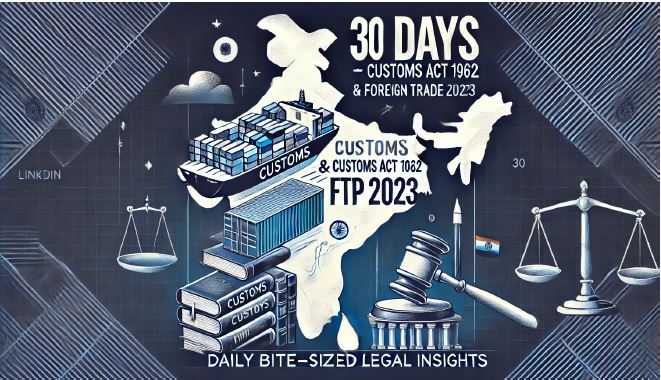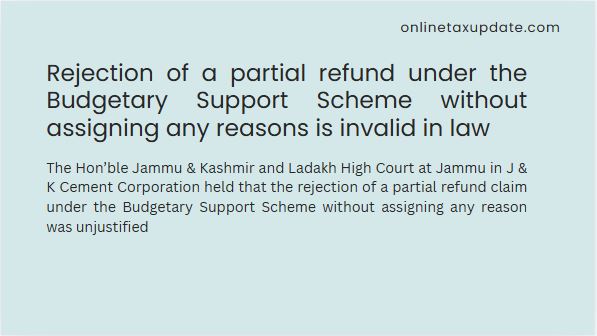Day 9 — “Beyond the Border, Within the Nation: SEZs, FTWZs & India’s Customs Territory”
Preface
Special Economic Zones (SEZs) intentionally blur India’s fiscal border: for Customs they are treated as a place outside India, yet for company law, labour law and many indirect taxes they remain firmly on Indian soil. Understanding that duality—especially after GST—lets professionals unlock duty-free supply chains while avoiding costly valuation or jurisdictional errors. Today’s note maps (i) the legal fiction created by the SEZ Act 2005, (ii) its integration with the Customs Act 1962 and IGST Act 2017, and (iii) the specialised Free Trade & Warehousing Zone (FTWZ) model.
1. Where exactly is an SEZ?
| Statute | Core deeming provision | Practical effect |
| SEZ Act 2005 | Section 53 (1) — every SEZ “shall be deemed to be a territory outside the customs territory of India for the purpose of undertaking authorised operations” | Goods/services entering from the Domestic Tariff Area (DTA) are “exports”; exits to DTA are “imports”. |
| SEZ Act 2005 | Section 30 — DTA clearances attract “duty of customs… as if the goods were imported” | DTA buyer pays BCD + IGST; valuation under Customs Valuation Rules 2007 as imported goods. |
| IGST Act 2017 | Section 16 — supplies to or by SEZ units/developers are “zero-rated” | Supplier may export under LUT/bond or pay IGST and claim refund; no GST cash flow inside the zone. |
| Customs Act 1962 | Section 46, 68, 69 | Imports by SEZ file regular Bills of Entry; exports use Bill of Export – processed by Customs officers posted under the Development Commissioner. |
2. Nitty-gritties of SEZ operations
2.1 Imports & Domestic Procurement
- Rule 26, SEZ Rules 2006: SEZ unit/developer may import or procure from DTA without BCD, IGST or cess for authorised operations.
- DTA supplier treats the sale as an inter-State, zero-rated supply (IGST Section16); choose LUT/bond or pay IGST and claim refund.
2.2 Exports & Net Foreign Exchange
- Units must maintain cumulative positive NFE over five years (Rule 53).
- Drawback accrues on DTA – >SEZ supplies (Section 26 (d) SEZ Act); claim processed in the zone
2.3 DTA Sales
- BCD + IGST payable under Section 30; value determined per Customs Valuation Rules (Rule 48).
2.4 Sub-contracting & Temporary Removal
- Annual permission for job-work outside zone (Rule 41); goods must return in 120 days, else duty leviable.
2.5 Waste & Destruction
- In-zone destruction of scrap/waste without duty after intimation (Rule 39).
3. FTWZ — the Warehousing-first SEZ
Section 2 (r) read with Section 53 classifies Free Trade & Warehousing Zone as a category of SEZ aimed at trading, trans-shipment and logistics.
| Feature | FTWZ | Regular manufacturing SEZ |
| Primary authorised operations | Bulk warehousing, inventory management, labeling, kitting, re-export | Manufacture, re-packing, service delivery |
| Developer norms | Minimum 40 ha; built-up warehousing ≥ 100,000 m² (Rule 5 (2)(b)) | Sector-specific area norms |
| Customs posture | Goods may be kept indefinitely duty-free; breakbulk allowed without triggering import | Duty-free only for authorised operations tied to unit’s LOA |
| GST angle | Intra-FTWZ transactions do not trigger GST; supply to SEZ manufacturer zero-rated; supply to DTA = import | As per general SEZ rules |
FTWZs thus function as bonded logistics parks with the political certainty of the SEZ Act rather than the discretionary licensing of Section 65 bonded warehouses (MOOWR).
4. Interface with the Foreign Trade Policy (FTP) 2023
The Foreign Trade Policy 2023 (in force from 1 April 2023 and open-ended thereafter) expressly dovetails with the SEZ/FTWZ customs fiction in three practical ways:
- Zero-rated, export-equivalent status preserved – FTP 2023 reiterates that supplies to or by SEZ units/developers are treated as “exports” for every DGFT scheme, keeping them eligible for duty drawback, RoDTEP/ROSCTL and other export-linked benefits while remaining exempt from GST at the point of supply.
- Scrap and waste disposal clarified – Para 2.33 of Chapter 2 now allows any SEZ unit/developer to remove manufacturing scrap or waste into the Domestic Tariff Area without a DGFT authorisation, subject only to payment of normal customs duty, removing a recurring compliance bottle-neck for engineering and metals clusters.
- Alignment with bonded-logistics vision – FTP 2023 expressly recognises FTWZs as a sub-category of SEZs geared to regional trading and consolidation; the policy therefore routes all FTWZ imports through duty-free SEZ procedures while permitting seamless re-export or duty-paid DTA clearances, mirroring the customs treatment explained in Section 2 & 3 above.
5. Quick compliance map
- Registration: IEC+GSTIN; separate SEZ-GST registration (Circular 2/2017-GST).
- Bond-cum-Legal Undertaking: executed before first import.
- E-Sanchit & e-IGM: submit digital docs; tagging of “SEZ” ensures RMS autoout- of-charge.
- E-Way Bill: required for movement into/out of zone over ₹ 50k
- Annual Performance Report: file with Development Commissioner; customs officer verifies NFE
6. Key Differences between the Legacy SEZ Act 2005 and the proposed SEZ (Amendment) Bill 2024
The 2024 Bill builds on Budget-2022’s promise to transform SEZs into “Development of Enterprise and Service Hubs” but, unlike the shelved DESH draft, keeps the positive-NFE test and the SEZ brand while liberalising domestic sales, currency rules and approvals. In effect, it grafts bonded-warehouse flexibility onto the SEZ statute, aligns GST zero-rating with FTP 2023, and lets States co-design incentive menus. Practitioners should start scenario-mapping duty exposure on DTA sales and revisiting vendor contracts to switch from forex to rupee billing once the Bill is enacted.
| Axis of comparison | SEZ Act 2005 (current law) | SEZ Amendment Bill 2024 (draft) | Practical impact |
| Purpose clause / nomenclature | Promotes export‐led growth through “Special Economic Zones” (Section 3) | Retains the SEZ label but remodels enclaves as “development hubs” with wider service-sector mandate; earlier DESH draft has been folded into this text | Opens the door for logistics, R&D and domestic-oriented services, not just merchandise exports |
| Territorial fiction | Section 53(1) deems SEZ outside India’s customs territory for authorised operations | Fiction retained but Bill inserts a proviso permitting regulated domestic-market (DTA) sales without treating the entire transaction as an ‘import’ | Units may sell finished goods/services in India on payment of calibrated duties rather than full BCD/IGST |
| Positive Net Foreign- Exchange (NFE) | Mandatory 5-year cumulative positive NFE (Rule 53) | Bill continues the positive NFE yardstick after industry pushback | Ensures export orientation while giving room for larger domestic sales |
| Currency of realisation | DTA must pay SEZ in convertible foreign exchange (Rule 47) | Enabling clause to accept rupee payments for notified critical sectors; forex rule may be dropped altogether | Removes 3 % forex conversion cost and broadens the domestic customer base |
| DTA clearances & duty model | Section 30: full customs duty on transaction value of finished goods | Duty likely only on import content small equalisation cess; framework mirrors bonded warehouse Section 65 model | Makes SEZ output cost competitive with FTA imports and MOOWR units |
| Approval architecture | Two-tier: Board of Approval (BoA) + Unit Approval Committee (UAC) with multiple reporting lines | Single-window digital approval; statutory 45-day decision clock; appeals sent to a designated Appellate Committee | Predictable timelines and lower entry barrier for MSME units |
| Role of States | Limited to recommending zone proposals; most powers rest with Centre | States made joint partners in zone governance; empowered to notify sector-specific incentives and labour dispensations | Customised policies, faster land pooling, deeper political buy-in |
| Tax incentive regime | 100 % profit deduction under Section 10AA IT Act for 5+5+5 years (sunset 30 Jun 2020) | Draft promises targeted concessional corporate tax and additional GST refunds in lieu of the lapsed profit holiday | Restores fiscal attractiveness without clashing with BEPS Pillar 2 |
| Forex / trade compliance window | Manual BoE/BoEx processed by Specified Officer; separate customs and GST interfaces | Full ICEGATE integration, E-Sanchit documents, faceless assessment and a common portal for customs & GST credits | Reduces clearance time; aligns with Turant Customs architecture |
| Dispute resolution | Appeals under SEZ Act go to Commerce Secretary-led forum; high backlog | Dedicated SEZ Appellate Tribunal with 6-month disposal target; option of mediation first | Quicker closure of valuation and NFE disputes |
6. Key Judicial Precedents
| Sl. | Case & Citation | Principle established |
| 1 | Essar Steel Ltd v UoI (2009) | SEZ deemed foreign territory; DTA clearance rightly attracts customs duty. |
| 2 | SRF Ltd v CC (2015 S.C.) | Supplies from DTA to SEZ qualify as “exports” for duty drawback |
| 3 | Larsen & Toubro Ltd v CC (2015 SC) | Service tax exemption extends to works executed wholly within SEZ |
| 4 | Gujarat Pipavav Port Ltd v UoI (2016) | Port-related services to SEZ developers covered by zerorated benefit. |
| 5 | GMR Aero Technic Ltd v CC Hyderabad (2023 CESTAT) | Aircraft parts sent from SEZ to DTA for repair treated as “imports” on re-entry. |
| 6 | Syntel Telecom v UoI (2016 Bom HC) | Refund of service-tax on SEZ input services cannot be denied for procedural lapses. |
Practitioner Take-aways
- Treat every SEZ gate as a mini-port: file proper BoE/Bill of Export even for pencil-box samples.
- Remember GST duality: SEZ inward supplies are zero-rated; SEZ outward to DTA are imports—plan IGST cash-flow.
- Use FTWZ for regional hubs: indefinite duty deferment + repacking rights with simpler inventory controls.
- Monitor Section 30 valuations: customs routinely questions “transfer-price” DTA sales; keep contemporaneous import benchmarks.
- Timely APR & NFE: failure invites suspension of zone privileges and retrospective duty demand.
Feedback /suggestions welcome at CA Navjot Singh | navjot.singh@taxtru.in | +91 9953357935
Share this content:





Post Comment